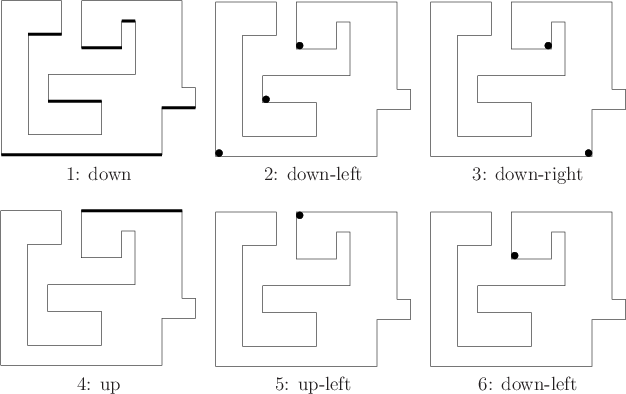
Next: 11.6 Computing Probabilistic Information Up: 11.5 Examples for Continuous Previous: 11.5.3 Examples with Nature
For some problems, it is remarkable that uncertainty may be reduced without even using sensors. Recall Example 11.17. This is counterintuitive because it seems that information regarding the state can only be gained from sensing. It is possible, however, to also gain information from the knowledge that some actions have been executed and the effect that should have in terms of the state transitions. The example presented in this section is inspired by work on sensorless manipulation planning [321,396], which is covered in more detail in Section 12.5.2. This topic underscores the advantages of reasoning in terms of an I-space, as opposed to requiring that accurate state estimates can be made.
 |
The tilt of the tray is considered as an action that can be chosen by the robot. It is assumed that the initial position of the ball (initial state) is unknown and there are no sensors that can be used to estimate the state. The task is to find some tilting motions that are guaranteed to place the ball in the position shown in Figure 11.28, regardless of its initial position.
The problem could be modeled with continuous time, but this
complicates the design. If the tray is tilted in a particular
orientation, it is assumed that the ball rolls in a direction,
possibly following the boundary, until it comes to rest. This can be
considered as a discrete-stage transition: The ball is in some rest
state, a tilt action is applied, and a then it enters another rest
state. Thus, a discrete-stage state transition equation,
![]() , is used.
, is used.
To describe the tilting actions, we can formally pick directions for
the upward normal vector to the tray from the upper half of
![]() ;
however, this can be reduced to a one-dimensional set because the
steepness of the tilt is not important, as long as the ball rolls to
its new equilibrium state. Therefore, the set of actions can be
considered as
;
however, this can be reduced to a one-dimensional set because the
steepness of the tilt is not important, as long as the ball rolls to
its new equilibrium state. Therefore, the set of actions can be
considered as
![]() , in which a direction
, in which a direction
![]() indicates
the direction that the ball rolls due to gravity. Before any action
is applied, it is assumed that the tray is initially level (its normal
is parallel to the direction of gravity). In practice, one should be
more careful and model the motion of the tray between a pair of
actions; this is neglected here because the example is only for
illustrative purposes. This extra level of detail could be achieved
by introducing new state variables that indicate the orientation of
the tray or by using continuous-time actions. In the latter case,
the action is essentially providing the needed state information,
which means that the action function would have to be continuous.
Here it is simply assumed that a sequence of actions from
indicates
the direction that the ball rolls due to gravity. Before any action
is applied, it is assumed that the tray is initially level (its normal
is parallel to the direction of gravity). In practice, one should be
more careful and model the motion of the tray between a pair of
actions; this is neglected here because the example is only for
illustrative purposes. This extra level of detail could be achieved
by introducing new state variables that indicate the orientation of
the tray or by using continuous-time actions. In the latter case,
the action is essentially providing the needed state information,
which means that the action function would have to be continuous.
Here it is simply assumed that a sequence of actions from
![]() is
applied.
is
applied.
The initial condition is ![]() and the history I-state is
and the history I-state is
| (11.74) |
It is surprisingly simple to solve this task by reasoning in terms of
nondeterministic I-states, each of which corresponds to a set of
possible locations for the ball. A sequence of six actions, as shown
in Figure 11.29, is sufficient to guarantee that the
ball will come to rest at the goal position, regardless of its initial
position.
![]()
Steven M LaValle 2020-08-14